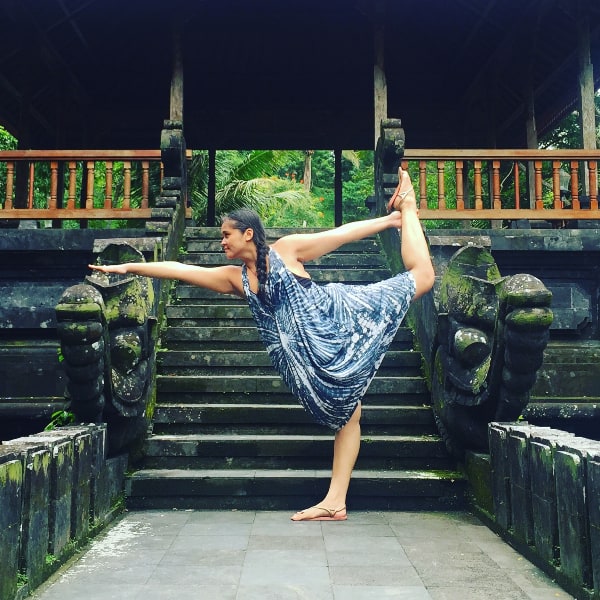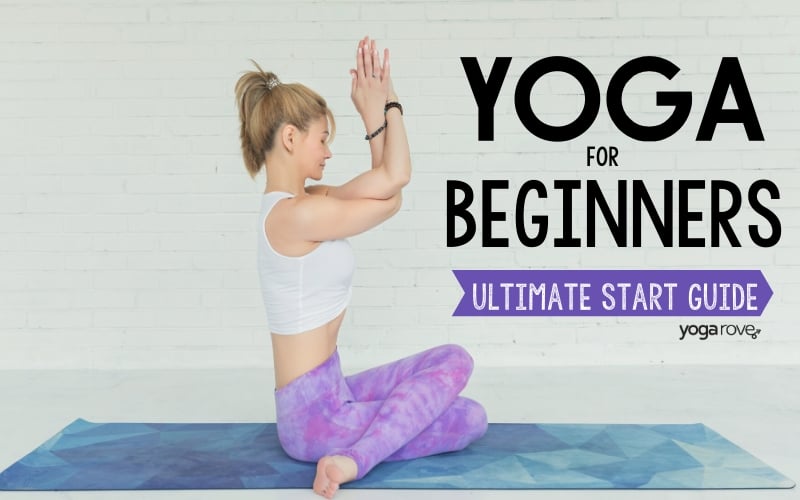This post may contain affiliate links. Please read our disclosure for more info.
It’s that pivotal moment right after your final savasana – you gently open your eyes and begin to peel yourself off of your mat. Somehow, you feel lighter, more alive, more spacious, and more connected to your breath and your body. And it feels amazing! What makes yoga feel so good? Millions of yogis all around the world are familiar with the incredible feeling that is nicknamed the ‘yoga high’.
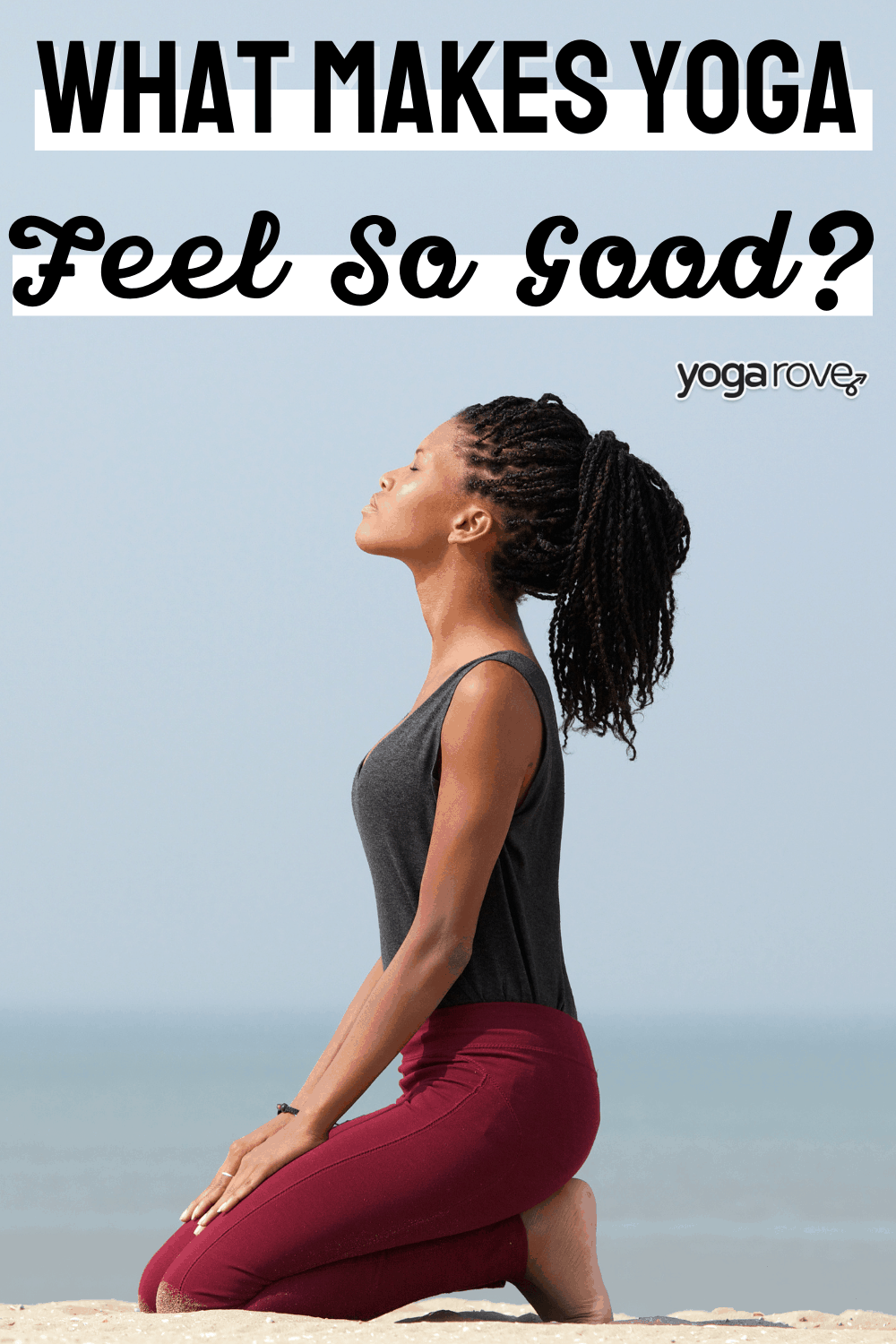
So what makes yoga feel so good? Practicing yoga helps you to feel calmer, relaxed, and more in tune with your body and yourself. In addition to boosting happy hormones in your body, yoga builds confidence, self-awareness, and mindfulness. This in turn makes you feel lighter, happier, and more alive.
The awesome part about this feeling is that it usually stays with you even after you step off of your mat. When you begin to practice yoga regularly, you will start to notice this feeling not only right after your savasana but throughout your daily life as well. You might find yourself not getting so stressed out about things that used to stress you out. Or you may begin to notice that you generally feel happier and more connected. The physical and emotional benefits of yoga keep yogis coming back for more.
Why Does Yoga Feel So Good?
When you practice yoga, you are not only strengthening our physical self but your internal self as well. Many yogis start out by coming to the practice simply for the physical benefits, which include strength, flexibility, muscular toning and definition, and increased stamina. However, once you begin to dive deep into the practice, it is likely that its spiritual, mental, and emotional benefits will keep you on your mat.
During your yoga practice, you tap into your body and your breath. Through stillness, connection, and breath, you are able to go inward and release stuck emotions. You are able to turn off your mind, focus on your body and your breath, and connect to your inner self. You may find yourself in your pigeon pose towards the end of class more able to relax, let go, and release. And when you step off of your mat, you feel lighter, more spacious, more open, and more alive.
And who doesn’t love that feeling? That feeling of weightlessness, connection, and relaxation feels amazing! Everyone has their own personal connection to their yoga practice and it is one that changes and evolves as your practice grows. However, there is no doubt that yoga allows us to go inward and connect to ourselves. This connection fosters more understanding of the self, more self-love, and more happiness from the inside out.
What Causes Me to Feel Good When I Do Yoga?
So why exactly do you feel a ‘yoga high’ after you step off of your mat? Is it because of a specific pose or breathing exercise? Or is it because of how your body responds to the practice? A regular yoga practice has numerous benefits to the mind and the body, and there are many reasons why you feel that you can conquer the world after your final savasana.
The practice of yoga:
- Lowers your levels of cortisol: When you are stressed, you are more likely to have higher levels of cortisol in your body. A regular yoga practice can lower your levels of cortisol, allowing you to feel happier and less stressed.
- Increases your endorphins: That ‘yoga high’ may be due to an increase of endorphins in your body. When you exercise, your body secretes endorphins that increase your mood and help you to feel less stressed.
- Strengthens your physical body: Finally, nail your crow pose or chaturanga? Feeling physically strong can inspire you and allow you to feel as if you can accomplish anything. This confidence can leave you feeling ready to conquer the world.
- Connects you to your inner self: With work, school, relationships, and all the pressures of daily life, it can be challenging to take a moment to just be with yourself. Yoga gives you the space to move inward and focus on your body, breath, and heart.
- Teaches you to breathe: Slowing down your breath, practicing pranayama, and being conscious and mindful of your breathing releases tension and stress in the body and takes you inward. Yoga’s deep breathing purifies your physical body and also teaches you to slow down and relax instead of adding more tension and stress to your body.
Why Does Yoga Make You Feel Calm?
If you are new to practicing yoga, one of the most challenging parts of practice may be the breath. Contorting your body into different shapes and breathing through challenging moments and postures can prove to be quite difficult at first. When our bodies our challenged, the body’s automatic response is ‘fight or flight’, which causes our breath to become shallow and fast.
However, in yoga, we are taught to breathe slowly, deeply, and consciously in and out of our noses. This type of breathing takes you into a more relaxed state, or a parasympathetic response, allowing you to relax and respond without ‘fight or flight’.
Yoga and Mindfulness
Similar to meditation, yoga teaches mindfulness. Mindfulness is the practice of being aware and conscious of the present moment. You also practice reacting to whatever comes up in a calm and relaxed manner. For example, when you are in a challenging pose, instead of letting your thoughts go wild and becoming frustrated or stressed, yoga teaches you to breathe, allow what comes up to come up, and react in a peaceful and calm way.
When you are more mindful and present on your mat, this practice becomes apparent off of your mat as well. You may find that when you are in a stressful situation at work, you go back to your yoga practice by taking deep breaths and grounding yourself in the moment. These practices allow you to stay calm during stressful moments and remind you not to let stressful thoughts and emotions take over.
What Type of Yoga Should I Practice to Feel Good?
There are tons of different styles of yoga, schools of yoga, and teachers of yoga. However, all types of yoga teach you to be present and mindful and build a connection to your body and to yourself. If you are new to yoga, try out different practices to see what you resonate with the most. Some yogis find that a sweaty, hot yoga practice leaves them feeling on top of the world, while others prefer a slower, more restorative practice to help them feel centered and connected.
It is also a great idea to mix up your yoga practice. If you generally practice stronger, dynamic yoga styles, complement your practice with a restorative yoga class. You may find that different styles work together to keep you feeling energized, strong, centered, and calm. Yoga may also lead you to more mindfulness-centered practices like pranayama and meditation.
Yoga Poses That Make You Feel Energized
Feeling a little sluggish and looking to reenergize or up your mood? You can practice the following poses for a little pick me up during your lunch break or to start your day. If you are making your way into a deeper pose, make sure that you sufficiently warm up with some Cat/Cow stretches or Sun Salutations.
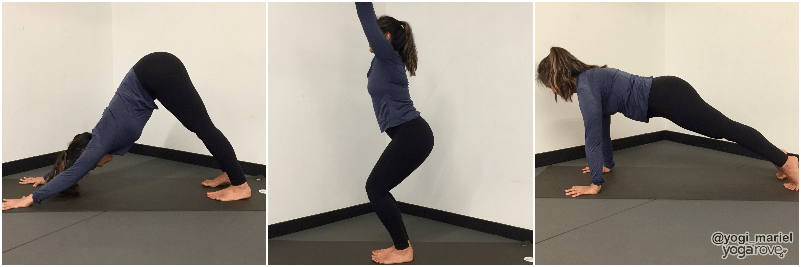
- Downward Facing Dog: This pose works every part of your body and can leave you feeling energized and strong. Because your head is below your heart, the shape of downward dog increases your body’s circulation, bringing more energy into your entire body. Inversions typically boost your energy and are a great way to find a little more pep in your step during a long day.
- Chair Pose: In Sanskrit, chair pose is known as ‘Utkatasana’, which translates to proud or fierce. A challenging pose, this posture works your thighs, glutes, and core and helps you to lengthen your spine and lift your heart. Feel proud, strong, and fierce after practicing this posture.
- Plank Pose: A strong and dynamic posture, plank pose engages and energizes your core. Holding plank pose for a few long, deep breaths can help you to break a sweat and get your blood flowing.
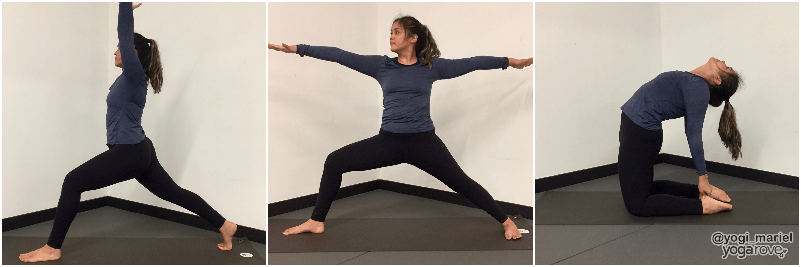
- High Lunge: A powerful posture, high lunge requires concentration to hold in the proper alignment. Feel your heart lift and your legs fire up in this strong, standing pose.
- Warrior 2: Stand tall like a proud warrior in Warrior 2 and feel every part of your body strong, engaged, and grounded. This pose allows you to feel rooted and strong and energizes your arms and your legs.
- Camel Pose: Backbends in your yoga practice allow you to feel open and expansive. Camel pose releases stored energy and leaves you feeling renewed and reenergized with its deep backbend.
Related Questions
Is yoga the same as meditation? While yoga and meditation share similar aspects, yoga is more of a physical practice than meditation. During a meditation practice, you are likely still with your eyes closed, while yoga incorporates movement and poses.
How do I breathe during yoga? During your practice, work on finding a slow, deep, even breath in and out of your nose. You can practice Ujjayi breath as you flow through your practice.


